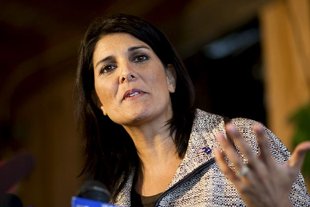December 29, 2016
London: In a year dominated by Brexit and Donald Trump’s surprise US election win, Asia felt like a relatively stable part of the world. A closer look shows that the region endured its own seismic events in 2016, from a Philippine leader embracing China to massive street protests in Seoul to the elimination of 86% of India’s hard currency.

December 29, 2016
London: In a year dominated by Brexit and Donald Trump’s surprise US election win, Asia felt like a relatively stable part of the world. A closer look shows that the region endured its own seismic events in 2016, from a Philippine leader embracing China to massive street protests in Seoul to the elimination of 86% of India’s hard currency.

Prime Minister Narendra Modi dominates Indian politics in a way unseen in decades. Photo: Reuters
Here we look at how key leaders performed. They are listed in order of the size of their economy.
Chinese president Xi Jinping
Xi Jinping, 63, further consolidated power in 2016 after Communist Party leaders declared him the “core,” a designation that strengthens his hand ahead of a twice-a-decade power reshuffle in late 2017. Xi also shone internationally, hosting G-20 leaders for the first time and positioning China as a leading advocate for free trade and the fight against climate change in the wake of Trump’s election win.
Biggest challenge in 2017: Responding to Trump’s tougher line on issues like trade and Taiwan while ensuring China’s economic recovery stays on track amid the power transition.
Japanese prime minister Shinzo Abe
Shinzo Abe, 62, ends 2016 with the sort of support levels that may convince him to call an election in 2017, giving him a chance to become the longest-serving leader since World War II. While Trump’s win dealt a blow to Abe’s push for an Asia-Pacific trade pact, he rounded off the year by seeking progress on a territorial dispute with Russia and becoming the first Japanese prime minister to visit Pearl Harbor in decades—both popular moves at home.
Biggest challenge in 2017: Navigating relations with China while convincing Trump of the importance of the US-Japan alliance.
Indian Prime Minister Narendra Modi
Narendra Modi, 66, dominates Indian politics in a way unseen in decades. His move to abolish 86% of hard currency overnight on 8 November showed that he’s willing to risk imposing hardship on millions of people to implement his vision of a modern India: Free of corruption, fewer internal trade barriers and a tougher line against archrival Pakistan.
Biggest challenge in 2017: Reviving the economy after his surprise cash ban dented India’s growth prospects, while also fighting a bellwether election in India’s largest state and rolling out a national goods-and-services tax.
Every year, Forbes ranks the world's most powerful people from all walks of life, measuring their strength on four scales: their power over other people, financial resources controlled by them, their power in multiple spheres and if they actively used their power. In 2016, 74 men and women were chosen to be on this prestigious list. Let's take a look at the top 20.
South Korean president Park Geun-hye
Park Geun-hye, 64, easily had the worst year of all Asian leaders. She was impeached Dec. 9 over an influence-peddling scandal after weeks of protests drew hundreds of thousands into the streets calling for her resignation. If the constitutional court approves the impeachment motion, Park will lose her presidential immunity and an election will be held in 60 days. The prime minister has temporarily taken charge.
Biggest challenge in 2017: Staying out of jail.
Australian prime minister Malcolm Turnbull
After Malcolm Turnbull, 62, saw his parliamentary majority reduced to one seat in a July election, he has struggled to stimulate an economy still in transition from a mining boom. Beholden to the right wing of his party, his popularity has sagged as he has adopted policies that appear to run counter to past positions on issues like climate change and same-sex marriage.
Biggest challenge in 2017: Staving off a potential leadership battle in his party.
Indonesian president Joko Widodo
Joko Widodo, 55, asserted his authority over Indonesia’s political establishment in 2016. With a mix of patronage and political savvy, he controls more than two-thirds of seats in parliament—support he used to pass a controversial tax amnesty bill in June to help fund an infrastructure program.
Biggest challenge in 2017: Ensuring that his plans to bolster economic growth aren’t derailed, particularly as he looks to placate Islamic groups looking to prevent one of his allies from becoming Jakarta’s first elected Christian governor.
Malaysian prime minister Najib Razak
Najib Razak, 63, appears to be weighing early elections to secure his grip on power, a move that would display his confidence in weathering more than a year of political attacks over allegations he took $1 billion from a state-owned investment company—charges he denies. This month a court upheld a sodomy conviction for Anwar Ibrahim, effectively sidelining Najib’s chief rival and leaving the opposition in disarray.
Biggest challenge in 2017: Najib will have to check rising living costs for his Malay base while keeping the fiscal deficit under control to keep investors happy, particularly as market volatility hits the ringgit.
Philippine president Rodrigo Duterte
Rodrigo Duterte, 71, remains highly popular in the Philippines despite international criticism over a war on drugs that killed as many as 5,000 people since he took power in June. He’s repeatedly questioned his nation’s alliance with the US in expletive-laden outbursts while moving closer to China, a geopolitical shift that has rocked the region.
Biggest challenge in 2017: Balancing relations with the US and China in a way that keeps the economy humming and prevents challenges to his rule from business and military elites.
Courtesy: Bloomberg
















































































































